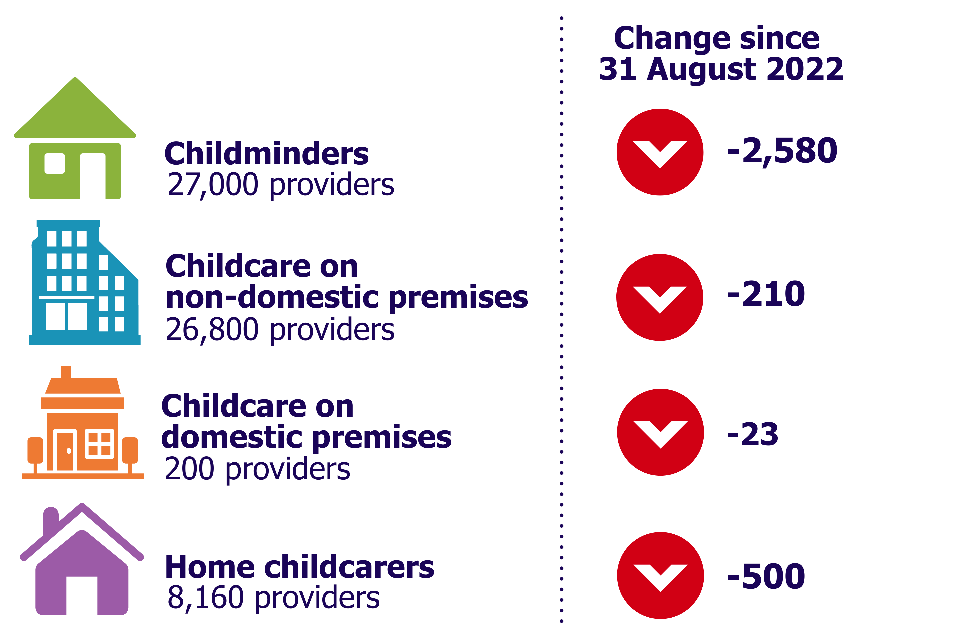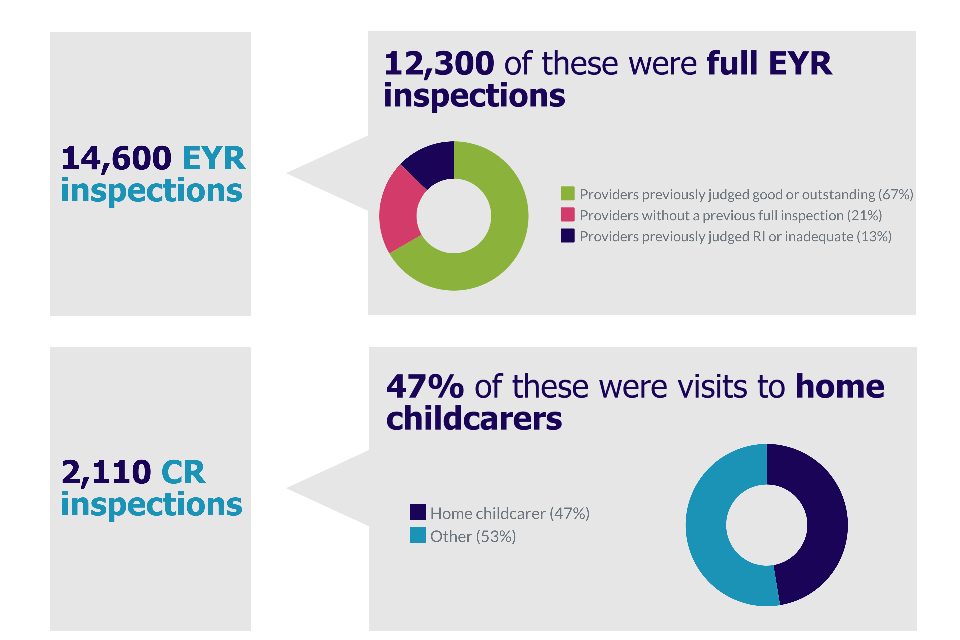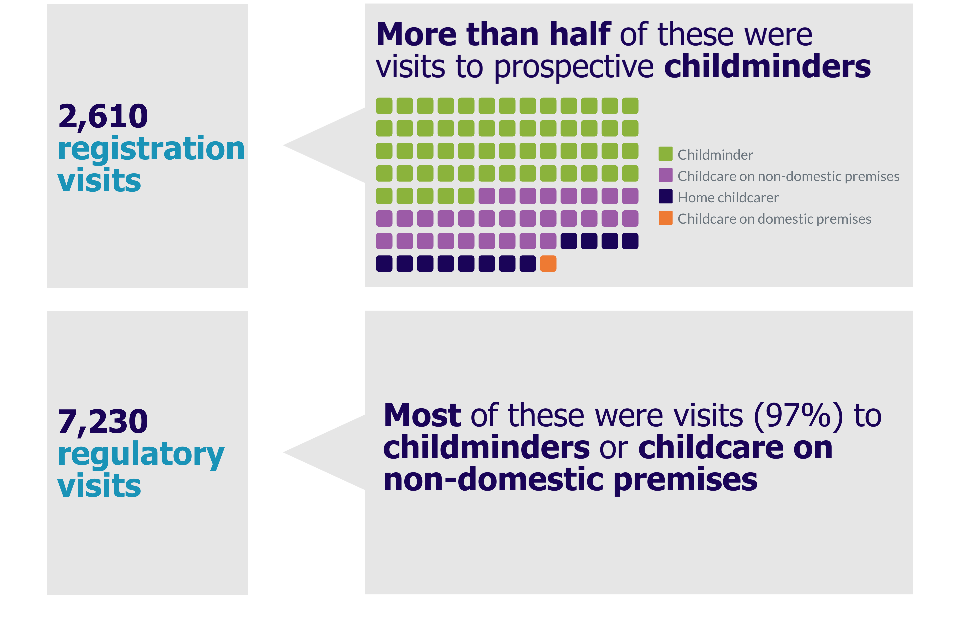Main findings: childcare providers and inspections as at 31 August 2023
Published 17 November 2023
Applies to England
This is the main findings report for the childcare providers and inspections as at 31 August 2023 release. The following are also available:
- underlying data
- methodology
- pre-release access list
Summary
This release includes:
- the number of Ofsted-registered childcare providers on 31 August 2023 and their most recent inspection outcomes
- data on inspections and regulatory activity carried out until 31 August 2023
Summary of findings
On 31 August 2023:
- There were 62,300 childcare providers registered with Ofsted, down by 3,320 (5%) since 31 August 2022. Most of this decline is due to a fall in the number of childminders.
- There were 1.26 million childcare places offered by providers registered on the Early Years Register (EYR), down by 17,800 (1%) since 31 August 2022. This means that the number of places is falling more slowly than the number of providers.
- At their most recent inspection, 96% of childcare providers were judged good or outstanding, the same as last year.
Introduction
The early years and childcare sector is primarily made up of private nurseries, pre-schools and childminders. In this publication, we refer to 4 types of early years provision:
Childminders
These are people who look after children for payment or reward, in a home that is not the child’s own. Childminders have the option to register either with Ofsted or with a childminder agency.
Childcare on non-domestic premises
These are nurseries, pre-schools, holiday clubs and other group-based settings.
Home childcarers
These are individuals who care for children wholly or mainly in the child’s own home (for example, nannies).
Childcare on domestic premises
These are providers where 4 or more people look after children together in a home that is not the child’s. Providers of childcare on domestic premises have the option to register either with Ofsted or with a childminder agency.
Further information about provider types is available in the glossary.
Childcare in early years is also provided in the schools sector. It is offered in state-funded schools and independent schools. For more information, see the early years provision in the schools sector section of this page.
Providers, places and registers
Number of providers
There were 62,300 childcare providers registered with Ofsted on 31 August 2023, down by 3,320 (5%) since last year.
Figure 1: Childcare providers registered with Ofsted on 31 August 2023, by provider type

See the notes section for rounding guidelines.
View data in an accessible table format.
Joiners and leavers in the childcare sector over time
The number of active providers on our registers has been falling since 2016. This is because more providers are leaving the childcare sector than joining (see Figure 2), and is mainly due to a fall in the number of childminders.
Figure 2: Joiners and leavers in the childcare sector, by academic year

Most leavers are providers who have resigned from our registers, rather than providers who have had their registration cancelled by Ofsted. Most joiners are new provider registrations. Some will be providers moving from the EYR to the Childcare Register (CR), or resigning from one register but remaining on the other.
View data in an accessible table format.
Places
On 31 August 2023, there were 1.26 million childcare places offered by providers registered on the EYR, down by 17,800 since last year.
Data on places is reported for the 48,100 providers registered on the EYR and is first gathered at registration and updated at inspection.
Childminders offer fewer childcare places than other providers on average. The decline in the number of childcare providers is mostly due to the falling number of childminders. This means the number of places has not decreased at the same rate as the number of providers. While the number of providers has fallen by 5% since 31 August 2022, the number of places has only decreased by 1%.
For methodological notes on places data, see the methodology and quality report that accompanies this release.
Figure 3: Number of childcare places offered by providers on the EYR on 31 August 2023, by provider type

See the notes section for rounding guidelines.
This includes places for children under 8 at providers that are registered on both the EYR and the CR.
View data in an accessible table format.
Registers
On 31 August 2023, 77% (48,100) of Ofsted-registered childcare providers were on the EYR. The remaining 23% were only registered on the CR.
Childcare providers can be registered on one or more of the following registers:
- Early Years Register (EYR)
- Childcare Register (CR), which is divided into 2 parts:
- compulsory
- voluntary
Further information about these registers is in the glossary.
Inspections and regulatory activity
Most recent inspections of providers on the EYR
Of the EYR providers that have had a full inspection, 96% were judged good or outstanding at their most recent. This has remained the same since 31 March 2022.
Since 31 August 2019, the proportion of outstanding childcare providers has fallen from 20% to 14%.
Figure 4: Overall effectiveness of active early years registered providers over time at their most recent inspection

See the notes section for rounding guidelines.
Numbers in brackets refer to the number of inspected providers.
Percentages are rounded and may not sum to 100 or to the totals reported in the text.
View data in an accessible table format.
As at 31 August 2023, 79% (38,000) of eligible providers on the EYR had received a full inspection under the education inspection framework. Full EYR inspections result in a graded judgement of outstanding, good, requires improvement or inadequate.
Inspections and regulatory activity between 1 September 2022 and 31 August 2023
Around 12,300 events were full inspections of providers registered on the EYR. The remaining 2,330 inspections of providers registered on the EYR were to out-of-school settings or providers with no children on roll at the time of the inspection.
Around 2,520 (21%) events were first inspections of recently registered providers, and about 1,570 (13%) were inspections of providers previously judged requires improvement or inadequate.
Figure 5: Inspections and regulatory activity between 1 September 2022 and 31 August 2023


See the notes section for rounding guidelines.
Our agreement with the government is to inspect 10% of providers on the CR each financial year. The number of CR inspections reported above is by academic year and it may therefore not equal 10%.
The regulatory visits include face-to-face visits as well as remote visits by telephone call.
RI: requires improvement.
View data in an accessible table format.
Figure 6: Overall effectiveness of full EYR inspections carried out between 1 September 2022 and 31 August 2023, by previous inspection outcome

See the notes section for rounding guidelines.
Percentages are rounded and may not add to 100.
Numbers in brackets refer to the number of inspected providers.
Inspections previously judged requires improvement include a small number of inspections judged satisfactory (a grade under a previous inspection framework).
Data refers to the overall effectiveness of inspections rather than providers, as providers may have had multiple inspections during the year.
View data in an accessible table format.
The inspection outcomes of providers are likely to vary, depending on their previous overall effectiveness judgement. Providers that were previously judged good or outstanding were more likely to receive a good or outstanding judgement at their next inspection. Therefore, the overall effectiveness profile of providers may vary year on year, depending on which have been selected for inspection in the year to date.
Of the inspections that were previously judged requires improvement or inadequate, 74% improved to good or outstanding at their next full inspection.
Key judgements
As part of a full inspection under the EIF, an early years provider is graded on 4 key judgements:
- quality of education
- behaviour and attitudes
- personal development
- leadership and management
Figure 7: Overall effectiveness and key judgement outcomes of full EYR inspections carried out between 1 September 2022 and 31 August 2023

Percentages are rounded and may not add to 100.
View data in an accessible table format.
Of the full EYR inspections carried out since 1 September 2022, 85% were judged either good or outstanding overall. All these inspections were good or outstanding for quality of education and behaviour and attitudes.
The proportions of individual key judgements that were good or outstanding were:
- 85% for personal development and effectiveness of leadership and management
- 87% for quality of education
- 88% for behaviour and attitudes
Childminder agencies
Childminders and childcare on domestic premises providers can choose to register with Ofsted directly or to register with a childminder agency. Existing childminders and childcare on domestic premises can also choose to de-register with Ofsted and register instead with a childminder agency.
Ofsted inspects childminder agencies. The childminder agencies are responsible for carrying out annual quality assurance visits to the childminders who are registered with them.
Childminder agencies are only eligible for inspection when they have childminders on roll. There are only 2 overall effectiveness inspection outcomes: ‘effective’ and ‘ineffective’. On 31 August 2023, 7 childminder agencies were registered with Ofsted. Of these, 5 had childminders on roll and were therefore eligible for inspection. Of these 5 childminder agencies inspected, 4 were judged to be ‘effective’.
Early years provision in the schools sector
In state-funded schools, other than nursery schools, early years provision is given its own judgement as part of the overall inspection of the school. On 31 August 2023, around 12,000 state-funded schools had been given an early years judgement at their most recent school inspection. Of these, 87% were judged good or outstanding for overall effectiveness, and 91% were judged good or outstanding for early years provision.
On 31 August 2023, there were 380 state-funded nursery schools in England. We have inspected all of these, and 97% were judged good or outstanding at their most recent inspection (see Table 1). A large proportion (62%) of these nursery schools were judged outstanding and 35% were judged good.
Table 1: Overall effectiveness of open state-funded nursery schools on 31 August 2023
| All inspected nursery schools | Outstanding | Good | Requires improvement | Inadequate | |
|---|---|---|---|---|---|
| Number of nursery schools inspected | 380 | 240 | 140 | 9 | 2 |
| Percentage of inspected nursery schools | 100 | 62 | 35 | 2 | 1 |
Percentages may not add to 100 and figures may not add to totals due to rounding.
For more information on school inspections and outcomes, see our statistics on state-funded school inspections and outcomes. For more information on non-association independent school inspections and outcomes, see our statistics on non-association independent schools.
Please note that Ofsted only inspects non-association independent schools. The Independent Schools Inspectorate inspects association independent schools.
Notes
There is an explanation about the main uses of this data and the arrangements for quality assurance, as well as further contextual information, in the methodology and quality report accompanying this release.
The methodology and quality report also provides information on the strengths and limitations of the statistics.
Rounding
Numbers in this report are rounded as follows:
- numbers under 100 are not rounded
- numbers between 100 and 1,000 are rounded to 2 significant figures
- numbers over 1,000 are rounded to 3 significant figures
Education inspection framework
On 1 September 2019, we began inspecting under the EIF. The EIF helps to ensure that inspections are consistent across early years and childcare providers, maintained schools, academies, non-association independent schools and further education and skills providers in England. We evaluate the overall quality and standards of early years provision in line with the principles and requirements of the early years foundation stage statutory framework. Inspectors judge the overall effectiveness of the early years provision, taking into account 4 judgements:
- quality of education
- behaviour and attitudes
- personal development
- effectiveness of leadership and management
Glossary
Definitions of terms are in our statistical glossary.
Further information
We publish the following information on the inspection of early years providers:
- early years and childcare statistics
- EIF
- framework for the regulation of provision on the childcare register
Contact for comments or feedback
If you have any comments or feedback on this publication, contact Anita Patel on 03000 130 914 or Anita.Patel@ofsted.gov.uk, or the early years data and analysis team at childcaredataqueries@ofsted.gov.uk.
Annual Report
We will publish findings from our forthcoming Annual Report on 23 November 2023.
Acknowledgements
Thanks to the following for their contribution to this statistical release: Anna Ruddock, Richard Smith, Rebecca Vincent, Chris Dinham and Mundeep Gill.
Annex: data tables for figures
This section contains the underlying data in an accessible table format for all figures.
Data for figure 1: Childcare providers registered with Ofsted on all registers on 31 August 2023, by provider type
| Provider type | Number of providers on 31 August 2023 | Change since 31 August 2022 |
|---|---|---|
| Childminders | 27,000 | -2,580 |
| Childcare on non-domestic premises | 26,800 | -210 |
| Childcare on domestic premises | 200 | -23 |
| Home childcarers | 8,160 | -500 |
See Figure 1.
Data for figure 2: Joiners and leavers in the childcare sector, by academic year
| Academic year | Joiners | Leavers | Total number of providers |
|---|---|---|---|
| 2015/16 | 9,742 | 14,140 | 72,954 |
| 2016/17 | 10,023 | 12,060 | 70,636 |
| 2017/18 | 9,143 | 10,874 | 69,785 |
| 2018/19 | 7,871 | 10,597 | 68,331 |
| 2019/20 | 7,683 | 8,549 | 67,653 |
| 2020/21 | 7,141 | 11,497 | 63,839 |
| 2021/22 | 5,849 | 11,256 | 59,724 |
| 2022/23 | 6,505 | 9,821 | 55,752 |
See Figure 2.
Data for figure 3: Number of childcare places offered by providers on the EYR on 31 August 2023, by provider type
| Provider type | Number of places on 31 August 2023 | % of total places on the EYR |
|---|---|---|
| Childcare on non-domestic premises | 1,090,000 | 86% |
| Childcare on domestic premises | 4,810 | <1% |
| Childminders | 166,000 | 13% |
See Figure 3.
Data for figure 4: Overall effectiveness of active early years registered providers over time at their most recent inspection
| Number of inspected providers | % providers judged outstanding | % providers judged good | % providers judged requires improvement | % providers judged inadequate | |
|---|---|---|---|---|---|
| 31 August 2023 | 38,000 | 14 | 83 | 2 | 1 |
| 31 August 2022 | 39,900 | 15 | 82 | 2 | 1 |
| 31 August 2021 | 40,900 | 17 | 80 | 2 | 1 |
| 31 August 2020 | 43,700 | 17 | 79 | 3 | 1 |
| 31 August 2019 | 49,800 | 20 | 76 | 3 | 1 |
See Figure 4.
Data for figure 5: Inspections and regulatory activity between 1 September 2022 and 31 August 2023
| Activity type | Number of events | Details |
|---|---|---|
| EYR inspections | 14,600 | 12,300 of these visits were full inspections. Of these, 21% were of providers without a previous full inspection, 67% were of providers previously judged good or outstanding, and 13% were of providers previously judged requires improvement or inadequate. |
| CR inspections | 2,110 | 47% of these visits were to home childcarers |
| Registration visits | 2,610 | More than half (57%) of these were prospective childminders intending to register on the EYR or CR, 30% were visits to childcare on non-domestic premises, 12% were visits to home childcarers and 1% were visits to childcare on domestic premises. |
| Regulatory visits | 7,230 | Most of these visits (97%) were to childminders or childcare on non-domestic premises. |
See Figure 5.
Data for figure 6: Overall effectiveness of early years registered providers inspected between 1 September 2022 and 31 August 2023, by previous inspection outcome
| Previous inspection outcome | Number of inspections | % providers judged outstanding | % providers judged good | % providers judged requires improvement | % providers judged inadequate |
|---|---|---|---|---|---|
| All full EYR inspections | 12,300 | 10 | 75 | 7 | 8 |
| Providers without a previous full EYR inspection | 2,520 | 10 | 76 | 7 | 8 |
| Providers previously judged good or outstanding | 8,180 | 11 | 75 | 6 | 8 |
| Providers previously judged requires improvement or inadequate | 1,570 | 2 | 73 | 14 | 12 |
See Figure 6.
Data for figure 7: Overall effectiveness and key judgement outcomes of full EYR inspections carried out between 1 September 2022 and 31 August 2023
| Judgement outcome | % providers judged outstanding | % providers judged good | % providers judged requires improvement | % providers judged inadequate |
|---|---|---|---|---|
| Overall effectiveness | 10 | 75 | 7 | 8 |
| Quality of education | 10 | 77 | 8 | 5 |
| Behaviour and attitudes | 11 | 76 | 7 | 5 |
| Personal development | 10 | 75 | 7 | 8 |
| Effectiveness of leadership and management | 10 | 75 | 7 | 8 |
See Figure 7.

